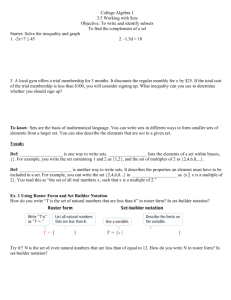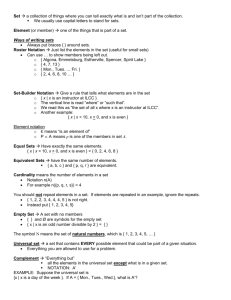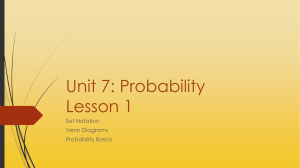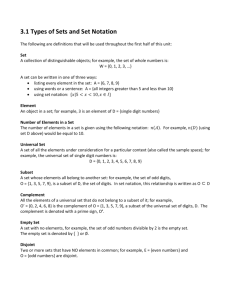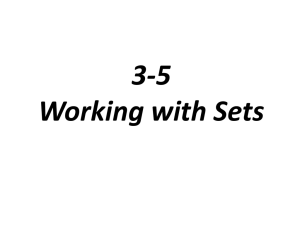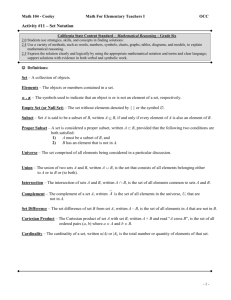2.1 Basic Set Concepts
advertisement
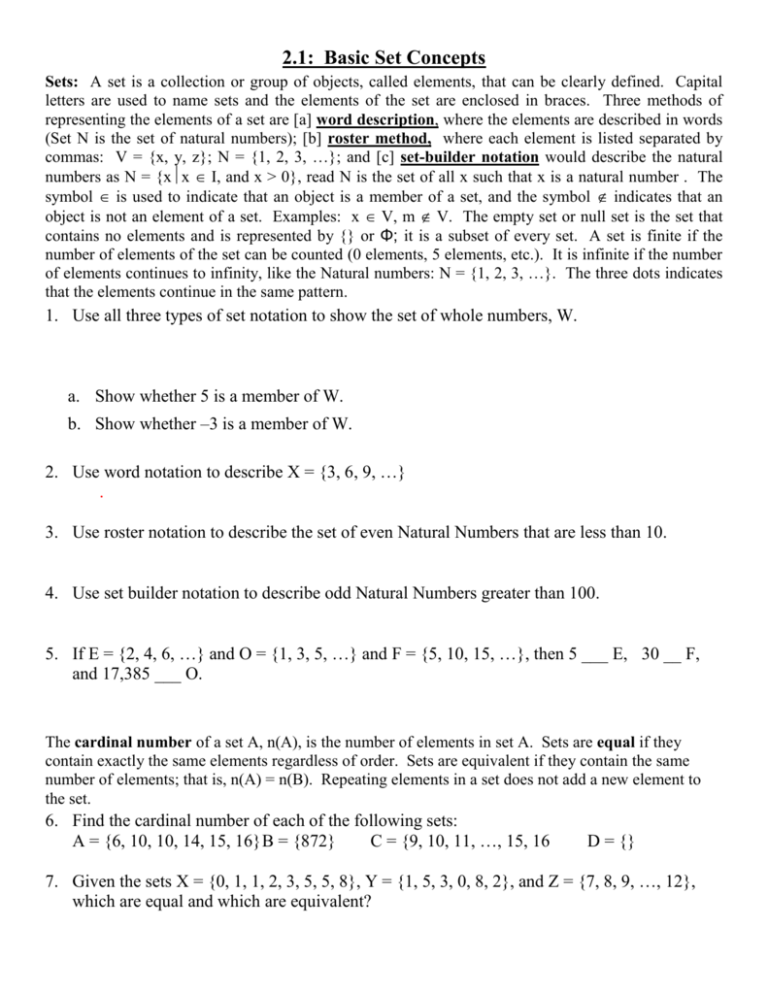
2.1: Basic Set Concepts
Sets: A set is a collection or group of objects, called elements, that can be clearly defined. Capital
letters are used to name sets and the elements of the set are enclosed in braces. Three methods of
representing the elements of a set are [a] word description, where the elements are described in words
(Set N is the set of natural numbers); [b] roster method, where each element is listed separated by
commas: V = {x, y, z}; N = {1, 2, 3, …}; and [c] set-builder notation would describe the natural
numbers as N = {xx I, and x > 0}, read N is the set of all x such that x is a natural number . The
symbol is used to indicate that an object is a member of a set, and the symbol indicates that an
object is not an element of a set. Examples: x V, m V. The empty set or null set is the set that
contains no elements and is represented by {} or Φ; it is a subset of every set. A set is finite if the
number of elements of the set can be counted (0 elements, 5 elements, etc.). It is infinite if the number
of elements continues to infinity, like the Natural numbers: N = {1, 2, 3, …}. The three dots indicates
that the elements continue in the same pattern.
1. Use all three types of set notation to show the set of whole numbers, W.
a. Show whether 5 is a member of W.
b. Show whether –3 is a member of W.
2. Use word notation to describe X = {3, 6, 9, …}
.
3. Use roster notation to describe the set of even Natural Numbers that are less than 10.
4. Use set builder notation to describe odd Natural Numbers greater than 100.
5. If E = {2, 4, 6, …} and O = {1, 3, 5, …} and F = {5, 10, 15, …}, then 5 ___ E, 30 __ F,
and 17,385 ___ O.
The cardinal number of a set A, n(A), is the number of elements in set A. Sets are equal if they
contain exactly the same elements regardless of order. Sets are equivalent if they contain the same
number of elements; that is, n(A) = n(B). Repeating elements in a set does not add a new element to
the set.
6. Find the cardinal number of each of the following sets:
A = {6, 10, 10, 14, 15, 16} B = {872}
C = {9, 10, 11, …, 15, 16
D = {}
7. Given the sets X = {0, 1, 1, 2, 3, 5, 5, 8}, Y = {1, 5, 3, 0, 8, 2}, and Z = {7, 8, 9, …, 12},
which are equal and which are equivalent?
2.2 Venn Diagrams and Subsets
The Universal Set is a set that contains all the elements under discussion, such as the set of all
dogs or all musicians or all real numbers.
Subsets: Set A is a subset of B, A B, if every
element of A is also a member of B. Set A is a proper subset of B, A B, if every element of A
is also in B but A B. A B indicates that A is not a proper subset of B. The null set or
empty set {} is a proper subset of every set except itself. The number of subsets of a set with n
elements is 2n. The number of proper subsets of a set with n elements is 2n - 1
If V = {x, y, z}, how many subsets and proper subsets can be found?
1. List all possible subsets of V, above.
2. Show whether N, the set of natural numbers, is a proper subset of W.
3. Show whether the set of negative numbers, M, are a subset of W.
4. Define a universal set for D = {collies, poodles, terriers}, C = {lions, tigers,
leopards}.
5. Define a universal set of D and C above plus A = {monkeys, birds, alligators}.
6. Given the set A = {lions, tigers, bears, and wolves} determine whether the following
statements are true or false: [a] bears A;
[b] bears A;
[c] {bears} A,
[d] Φ A;
[e] Φ A.
Complement: The complement of set A, A’, is the set of elements that are not in set A but are
in the universal set; that is, A’ = {xx U and x A}. If U = {0, 1, 2, …} and B = {0, 1, 2, …
100}, the complement of B is shown as B’ = {101, 102, 103, …}.
7. If J = {all months beginning with J}, find J’.
8
If the universal set is all integers and N = {1, 2, 3, …} , find N’.
Venn Diagrams: A rectangle is used to represent the universal set. Sets within the universal set
are depicted usually by circles. The region outside a circle but within the rectangle is the
complement of that set. The combination of any set and its complement gives the universal set.
Let U = all the letters of the alphabet and V = the vowels, draw a Venn Diagram to represent U,
V, and V’:
U
2.1 Class Practice
1. Write a description of the set: {4, 8, 12, 16, …}
2. Use roster notation to describe the set: {xx N and x lies between 42 and 48, inclusive}
3.
Use set-builder notation to describe the set: {15, 16, 17, …}
4. True or false: [a] 20 {2, 4, 6, …, 100}
[b] 12 {x N and x < 20}
5. Fill in the blank with or : ½ ___ {x|x N and x < 1}
6. Find the cardinality: {3, 6, 9, …, 21}
7. True or false: [a] {0, 3, 6, 9} = {3, 6, 9}
[b] {4, 8, 12, 16, 20} = {12, 4, 20, 16, 8, 4}
8. Are the sets equal or equivalent; explain:
[a] A = {States of the U. S.}, B = {governors of the U.S.}
[b] A = {6, 10, 2, 8, 4 }, B = {2, 2, 4, 4, 4, 6, 8, 8, 10, 10, 10, 10}
2.2
1. Let U = {x0 ≤ x ≤ 20}, A = {x|x/3 N}, B = {x5 < x ≤ 10}
[a] Find A’
[b] Find B’
[c] Draw a Venn Diagram.
2.
Fill in the blank with or : [a]{-3, -1} ____ {-5, -4, -3, …, 5}; [b] {t, a, b} ____ {b, a, t}
3.
Fill in the blank with or : [a]{-3, -1} ____ {-5, -4, -3, …, 5}; [b] {t, a, b} ____ {b, a, t}
4.
True or false:
5.
List all subsets: A = {2, 4, 6, 8, 10}
6.
Calculate the number of subsets: {x5 < x < 10}
[a] {2, 4, 6, 8, 10};
[b] {2, 4, 6, 8, 10}




